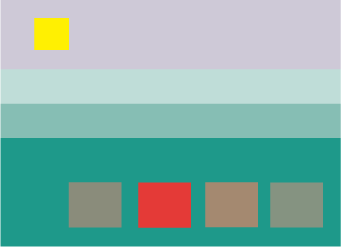You are here: Nature Science Photography – Image creation, Depth and Size – Space perception
The color perspective states that warm and rather dark colors, such as blue, or saturated colors and sharply defined color areas appear closer to us than cold and rather light color values, such as yellow or pastel tones or diffusely merging color areas. We can certainly explain the different depth effect of dark and light colors to a good extent with the knowledge we have just acquired with regard to aerial perspective. Beyond that, however, there is also a physiological explanation for the fact that colors from the long-wave (red) part of the spectrum have a closer effect on us than those from the short-wave (blue) part.
The field of optics teaches us that the shortwave and longwave regions of the spectrum are refracted at two different points in a simple lens system and that this results in overlapping color edges and impaired visual acuity. This aberration is called chromatic aberration. Our visual system suppresses it with various physiological measures, all of which result in a preference for the more easily controlled long-wave spectral range (see „Brightness and Color – Our preference for warm colors“). In addition, the following relationship is important for color perspective: when viewing objects of red, orange, or yellow color (long-wave), the lens in the eye is made more convex than when focusing on green, blue, or violet objects of the same size (short-wave), when it tends to be flattened to produce a sharp image. The more convex shape causes a slight magnification of the retinal image and that is why the red object appears closer to us than the blue one, which is actually identical in size. This difference in size, which is perceived due to the color, provides a clear depth gradation and promotes the impression of spatial expansion.

Next Factors of spatial imaging
Main Image creation, Depth and Size
Previous Atmospheric perspective
If you found this post useful and want to support the continuation of my writing without intrusive advertising, please consider supporting. Your assistance goes towards helping make the content on this website even better. If you’d like to make a one-time ‘tip’ and buy me a coffee, I have a Ko-Fi page. Your support means a lot. Thank you!


 Since I started my first website in the year 2000, I’ve written and published ten books in the German language about photographing the amazing natural wonders of the American West, the details of our visual perception and its photography-related counterparts, and tried to shed some light on the immaterial concepts of quantum and chaos. Now all this material becomes freely accessible on this dedicated English website. I hope many of you find answers and inspiration there. My books are on
Since I started my first website in the year 2000, I’ve written and published ten books in the German language about photographing the amazing natural wonders of the American West, the details of our visual perception and its photography-related counterparts, and tried to shed some light on the immaterial concepts of quantum and chaos. Now all this material becomes freely accessible on this dedicated English website. I hope many of you find answers and inspiration there. My books are on